70 years in the service: Eagle vs. Bear
Looking ahead, I will say a few things. Yes, B-52 is not an “Eagle” at all, it is a “Fortress in the Stratosphere”, but symbols still play a certain role for our story, so let the “Stratofortress” be an “Eagle”, especially since the eagle is a symbol of the USA , the same as a bear - a symbol of Russia.
And it’s impossible not to write about the Bear, they are practically the same age, so first we’ll talk about the American plane, then the Soviet-Russian one, and then there will be a separate result of the service of both machines, approaching a century and a half life for two.
Agree, they are worth it.
So, B-52 "Stratofortress".
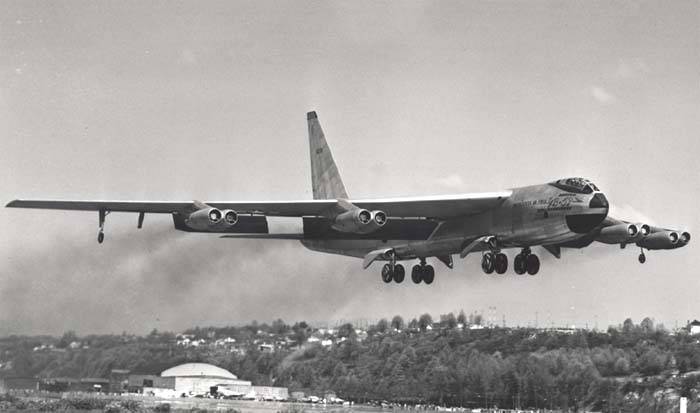
At the beginning of work on the creation of the B-52, there was nothing so “over the top”: the usual order for the development of an aircraft that would have to replace the B-36 from the Convair company, which, frankly, did not work out.
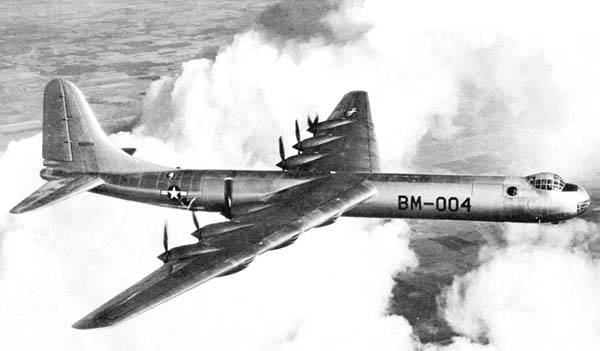
Yes, the B-36 entered history as the largest American aircraft, but its design, especially the mixed power plant, which consisted of piston and turbojet engines, was very far from perfect.
Therefore, Boeing simply decided to create a new aircraft, no one, most likely, even in their wildest dreams, could imagine that the car would take part in so many conflicts, last so many years and outlive all the creators.
It all started back in 1946, when the Peacemaker B-36 was just going to be tested. How they felt that it would not be long to serve him. The following parameters were announced: a range of 8 km, a bomb load of 000 tons, a flight altitude of 4,5 km, a speed of 10 km/h at an operating altitude of 700 km.
Boeing easily won the competition and received a contract to build a model. In the end, the company already had quite a decent experience in creating such aircraft: the Flying Fortress B-17, the Super Fortress B-29 became the most worthy representatives of the class of long-range heavy and strategic bombers of their time.
The union of the atomic bomb and the B-29 became a new step in the military doctrines of the two countries, the USA and the USSR, where the same B-29, but in the Soviet copyright Tu-4, was put into service. At the time the development of the B-52 began, this aircraft (B-29) became the only means of delivering atomic bombs to the territory of a potential enemy.
Piston aviation was nearing its sunset. Boeing made a bet on a plane with turbofan engines, and did not lose. More than 30 different combinations of wing geometries and power plant were considered, as a result, using the experience of the former German aircraft designers Vogt and Goetert, they settled on a long swept wing and eight turbojet engines under it.
In October 1948, Boeing submitted the final version of the bomber project, which received model number 464-49 with eight JT3 turbojets. The aircraft had a takeoff weight of 150 tons, could carry a combat load of 4,5 tons and had a range of 4 km. The estimated maximum speed was 930 km / h. In March 910, a new contract was signed with Boeing for the construction of two prototype aircraft.
The first flight of the XB-52 prototype took place on April 15, 1952. This moment must be taken as a starting point in the life of the aircraft.

The first flight of the serial B-52A took place on August 5, 1954, and the aircraft began to enter service from June 1955. The first planes went to training academies, and from June 1956 B-52Cs began to equip combat units.
It so happened that the resource included in the design made it possible not only to replace the outdated B-36 for a while, but to become the only until recently US strategic bomber capable of solving the tasks inherent in this class of aircraft, namely the delivery of strategic ammunition to targets on enemy territory.
In general, the life of the B-52 was successful in terms of various adventures. The aircraft was used not only for its intended purpose, but also as a carrier of numerous experimental space vehicles (HL-10, M2F3, X-24), from which the Space Shuttle program was later grown, the B-52 was carried by the unmanned reconnaissance aircraft Lockheed D- 21, it tested engines for the Boeing 747 and Lockheed C-5.
But the first truly historic event was the release of the first hydrogen bomb from the B-52 in May 1956.
The B-52 stamped records that more than illustrated the capabilities of this machine:
- in November 1956, a non-stop flight over the North Pole with a length of 27 km was completed;
- in January 1957, three B-52s made a group flight around the world, flying 45 km in 19 hours and 39 minutes;
- In January 1962, the B-52 set a flight range record without refueling, flying 20 km in 168 hours and 22 minutes.
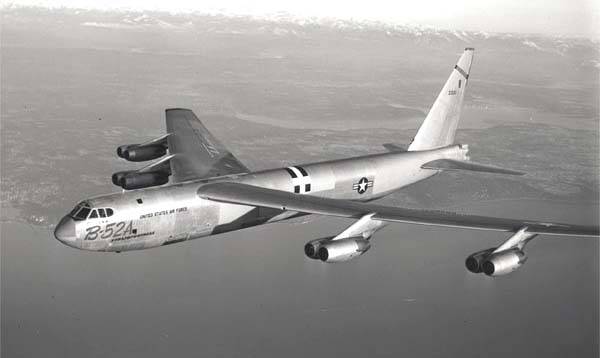
Naturally, bombers carried regular service. The planes were constantly on duty in readiness, made sorties on combat patrols, and by 1991, a total of B-52s had flown more than 6,5 million hours. 71 aircraft were lost in various incidents.
In 1991, President George W. Bush ordered the B-52 to be removed from duty in a state of readiness for a nuclear strike in connection with the collapse of the USSR.
However, up to this point, the aircraft managed to take the baptism of fire, and actually fight.
Of course, the B-52 was not used for its intended purpose. Yes, the plane was created as a strategic bomber, operating with free-falling nuclear bombs. There were no other types of weapons at that time. Naturally, he did not possess high accuracy, since there was no other way of pointing, except for optical sights. However, the power of atomic and nuclear bombs was quite forgiving of some deviation from the point of attack.
The first combat use of the B-52 occurred during the Vietnam War of 1965-1973 as a high-altitude bomber with conventional bombs.
The aircraft showed its very high efficiency. In the 52 years of the war, B-7s made almost 126 sorties, as a result of which the North Vietnamese army suffered great damage. B-000 gunners shot down 52 Vietnamese MiG-2 fighters in sorties. US Air Force losses amounted to 21 bombers: 30 were shot down by anti-aircraft missiles, 16 fighters, the rest were lost as a result of flight accidents, including through the fault of the damage received.
The "scorched earth" tactics carried out by the United States with the help of the B-52 caused a sharply negative assessment of the entire world community. But many years later, despite being equipped with radar sights, in operations in the Persian Gulf and Iraq, the B-52 was used exclusively for carpet bombing.
If we talk about the place of the B-52 in American strategy, then the aircraft was a head taller than the B-29, flew twice as fast and about a third higher. However, already in the sixties, progress began to make its own adjustments. Anti-aircraft missile systems appeared, which made the height at which the B-52 flew not as safe as we would like.
In October 1959, an S-75 air defense system with a Chinese crew (but under the guidance of Soviet specialists) at an altitude of 20 meters was shot down by a reconnaissance RB-600D of Chiang Kai-shek's army. In May 70, an American U-1960 reconnaissance aircraft was shot down over Sverdlovsk. In October 2, a similar aircraft was shot down over Cuba. In general, the level of capabilities of the S-1962 was demonstrated on November 75, 16, when an American reconnaissance balloon was shot down by an air defense system at an altitude of 1959 meters. Rockets were firmly in use and flights, even at very high altitudes, ceased to be a safe matter.
American developers did not sit idly by and improved the capabilities of the B-52. To break through the air defense of the USSR at high altitude, the aircraft received ADM-20 "Quail" target missiles and North American GAM-77 / AGM-28 "Hound Dog" guided cruise missiles, the last word in engineering at that time. The GAM-77 could carry a warhead weighing 750-800 kg for a range of 1100 km at a speed of Mach 2,1. The QUO was simply terrible, about 1850 meters, but the presence of a thermonuclear warhead neutralized this. Target missiles were supposed to take on the blows of Soviet missiles, taking them away from the aircraft.
In addition, the prospects for "training" the B-52 in low-altitude flight were seriously considered. The program gobbled up more than $200 million, strengthened the wing mounts and even replaced the wings themselves on many aircraft, but everything worked out partially. The 190-ton aircraft could fly at altitudes up to 300 meters at a speed of 600 km / h, but this required huge efforts from the pilots and more fuel for the engines.
As a result, the B-52 was used exclusively as a high-altitude bomber.
LTH B-52B
Wingspan, m: 56,39
Aircraft Length, m: 47,73
The height of the aircraft, m: 14,64
Wing area, м2: 371,6
Weight, kg
- empty aircraft: 74 426
- normal takeoff: 123 377
- maximum take-off: 190 508
Engines: 8 x Pratt & Whitney J57-P-19WA turbojet engines with a thrust of 4 kgf / 762 kgf on afterburner with injection of a water-methanol mixture
Maximum speed, km/h: 1014
Cruising speed, km / h: 842
Combat radius of action, km: 5 780
Max. rate of climb, m / min: 1450
Practical ceiling, km: 14417
Crew, prs: 6
Armament:
- four 12,7 mm M3 machine guns or two 20 mm M24A1 cannons
- bomb load - 19 504 kg
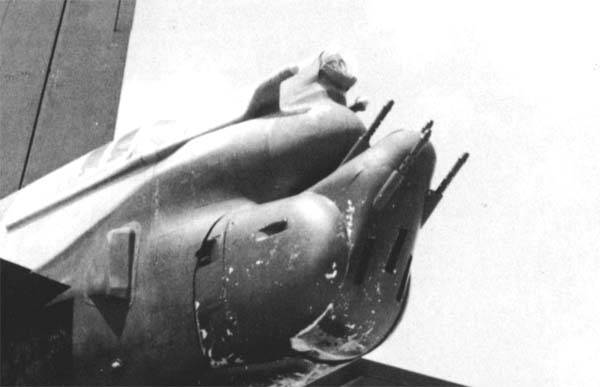
The next step in the development of steel B-52G / H
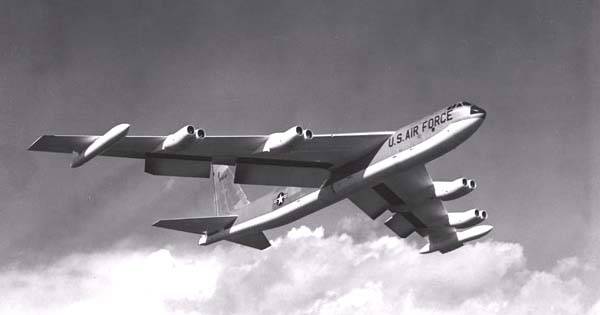
The first flight of the new aircraft took place in 1958. It really was a very radically redesigned B-52B.
The design of the wings was redesigned to increase the volume of fuel tanks, more powerful J-57-43W engines were installed (as in the E and F models), and the tail machine gun mount began to be controlled remotely. The aircraft received new navigation equipment and new sights, plus the Kwail electronic warfare system.
B-52G and B-52H - the first specialized missile carriers weapons. It was on these aircraft that the AGM-28 appeared. It was supposed to make the B-52 aeroballistic missiles GAM-87 "Skybolt", but the missile was not put into service.
In the seventies, B-52G / H began to be equipped with Boeing SRAM missiles with a W-69 nuclear warhead (100 Kt). The missiles could hit targets at ranges up to 160 km. The aircraft could take on board 8 missiles in the cargo hold in a special drum set, and another 12 missiles could be hung on external nodes. The missiles were intended to destroy enemy air defense centers, clearing space for aircraft with nuclear bombs on board.
In 1971-1977. All B-52G/H aircraft were equipped with the AN/ASQ-151 optoelectronic surveillance system, which significantly increased the combat capabilities of the aircraft at night, as well as when the enemy used nuclear weapons (television equipment, in combination with special curtains, prevented pilots from being blinded during a nuclear attack). explosion).
In 1985, part of the B-52G aircraft began to be equipped with NAVSTAR satellite navigation system receivers. At the same time, ALCM cruise missiles began to enter service, which, in principle, could attack targets without entering the enemy’s air defense coverage area. The missiles were intended primarily for air defense objects, after the suppression of which a breakthrough followed, followed by a blow with free-falling bombs or SRAM missiles.
The nineties brought bombers new AGM-86B missiles with nuclear warheads from Boeing. The ammunition load was all the same 20 missiles, 8 in a drum launcher inside the fuselage and 12 on external hardpoints. At the same time, the B-52 was armed with AGM-86C cruise missiles equipped with non-nuclear warheads. The armament set was supplemented with AGM-129 stealthy strategic cruise missiles (4 missiles on a drum launcher in the fuselage and 12 more missiles on external hardpoints).
Some of the B-52Gs were converted to carry Harpoon anti-ship missiles. "Harpoons" were attached only to the external hardpoints. Accordingly, the B-52G could carry 12 anti-ship missiles, or instead of the Harpoons, it was supposed to use Israeli-developed AGM-142 Raptor high-precision guided missiles.
With the end of the Cold War, reductions in the B-52 fleet began. The maximum number of B-52s in the ranks of the Strategic Command was in the 60-70s of the last century. Then the UK had more than 600 aircraft. But during the eighties, a significant number of B-52 bombers of the B, C, D, E and F series were withdrawn from service.
By the beginning of 1992, when it became clear that the USSR had practically collapsed, 254 B-52 aircraft remained in service with the US Air Force (159 B-52G and 95 B-52H), of which 33 B-52G were equipped to carry conventional bombs and RCC "Harpoon".
In August 1993, the destruction of 350 B-52 aircraft began at Davis-Monthan Air Force Base in Arizona in accordance with the START Treaty signed earlier with the USSR.
By 1994, 130 B-52 units remained in the US Air Force, but even that was not the end. As a result of all the reductions and disarmament, 85 aircraft remained in the strategic aviation. Another 20 aircraft are in reserve.
Basically, these are B-52H, built in the early 60s of the last century. However, the US Air Force Command plans to keep the bombers in service until the turn of 2040.
Most of the aircraft correspond to the B-52N modification and are non-nuclear carrier aircraft. 18 vehicles have been modified to carry and use Harpoons, 10 aircraft are armed with AGM-142 cruise missiles.
All bombers are equipped with the ICSMS non-nuclear weapon release control system from universal hardpoints. The system provides the use of a very wide range of modern high-precision weapons: JASSM missiles, JDAM, JSOW and WCM guided bombs.
But of course, nuclear weapons can be hung on any of these aircraft.
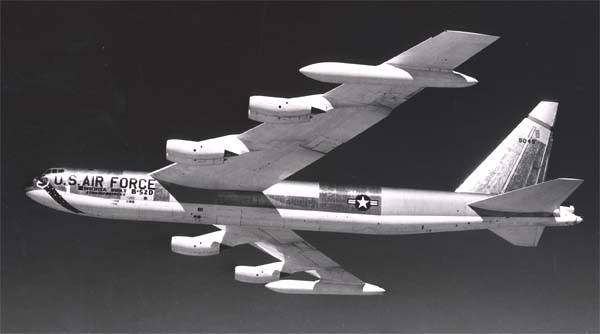
In general, only the fuselage, wings and engines remained from that B-52. Instead of cannons, the AN / ALQ-172 (V2) electronic warfare system appeared in the tail unit, the aircraft is equipped with a GPS satellite navigation system, but the satellite system is combined with an inertial navigation system that can duplicate the satellite one in the event of failure in the event of a nuclear war. The SPN/GEANS INS is based on laser gyroscopes, which is considered today to be a very advanced navigation system.
The optical-electronic sighting and surveillance system was replaced with a new AN / ASQ-151, which includes a forward-looking thermal imaging system and a new-generation surveillance television system. All information boards and indicators are changed from orange-red to blue-green to enable pilots to use MXU-810/U "Mark-4" type night vision goggles.
In our time, Boeing plans to modernize the avionics of the B-52N aircraft using elements of the equipment of the latest civil aircraft of its production. Multifunctional LCD displays and new universal weapon hardpoints should appear in the cockpits.
But all this is only possible if the US Congress approves the cost of modernizing all 66 bombers that will serve until 2040.
There is, however, one problem: engines. It is known that United Technologies, which owns this brand today, is not able to launch the production of Pratt & Whitney J57-P-43WВ engines for many reasons. The engines available on decommissioned aircraft somehow support the existence of the B-52, but their resource is dwindling before our eyes.
Allies came to the rescue of the Americans, who had signed their own impotence. Rolls-Royce agreed to provide its Rolls-Royce RB211-535E engines to power each B-52 with four of these engines, which, by the way, are used by Boeing 747s. The engine is not new, but there is simply no other in the foreseeable today.
The takeoff thrust of the RB211 is 19 kgf, while the thrust of two TF-400s is only 33 kgf. Thanks to the increased efficiency of British engines, the range of the B-15N without refueling will increase from 300 km to 52 km. Takeoff and landing distances will also be reduced.
The Boeing 757 was chosen as a donor for power elements (pylons and engine nacelles), which was discontinued in 2004, but which still flies.
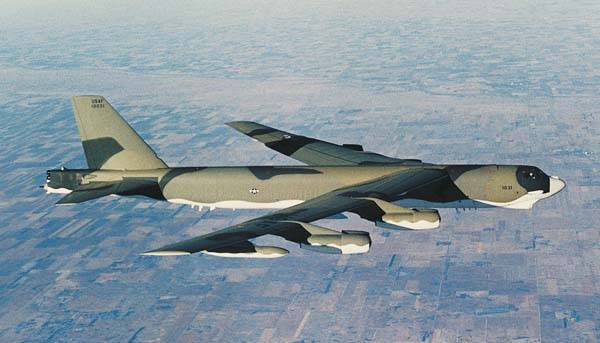
In fact, we are accustomed to the image of the B-52 as something ancient and archaic. Say, all he can do is throw out a mountain of bombs and create a lunar landscape somewhere.
In fact, the B-52 is still relevant today, since it can carry not only free-fall bombs, but also quite modern missile weapons.
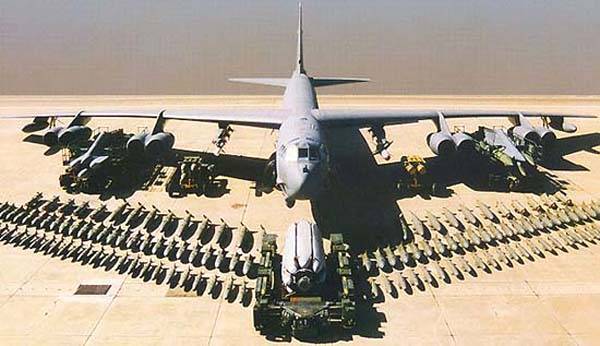
The practice of flying B-52 aircraft with nuclear bombs on board made them a source of very increased danger in peacetime. In two cases, the disasters were very real: in 1961, a B-52 with two nuclear bombs on board crashed near Goldsboro (USA), in the same year a B-52F with two thermonuclear bombs on board crashed near the city of Yuba City in California , and in 1966, another aircraft with four atomic bombs fell into the sea after a collision with a tanker near the city of Palomares (Spain). The bombs were brought to the surface after a long, difficult and costly rescue operation using deep submersibles.
A counter question arises for sure: why then was the B-52 used, like the B-29, that is, for carpet bombing, at the level of the Second World War?
Everything is simple. To answer this question, you just need to look at the list of countries against which this aircraft was used.
Vietnam. 1965-1973
Iraq + Kuwait. 1991.
Iraq. 1996, 1998 and 2003.
Yugoslavia. 1999.
Afghanistan. 2001 - 2021.
Syria. 2016.
As you can see, there were no countries that had an air defense system capable of resisting massive NATO air strikes. The exception is Vietnam, in which the United States lost 30 B-52 aircraft, the successes of other countries are more than modest. In Iraq, one B-52 was officially lost from the actions of the Iraqi side and 6 aircraft were damaged.
That is, there was no particular need to use expensive high-precision weapons. When Operation Desert Strike required strikes on power plants, two B-52s did it quietly with 12 cruise missiles.
By the way, in Syria, Russian aviation was also not particularly zealous in the use of high-precision weapons, operating mainly with conventional free-falling bombs.
The goal, you know, justifies the means spent on it. So a carpet of ordinary cheap high-explosive bombs can be, if not more effective than cruise missiles, then much cheaper.
So today, 70 years after its first flight, the B-52 is not an archaism that is living out its life because the US design idea has completely degraded. No, there is a certain degradation, there is nothing to even argue about, but in 1952 the B-52 was indeed ahead of its time in many ways.
And even today, after 70 years, despite a decent number of problems associated primarily with age and physical fatigue of the structure, this is a combat aircraft. Able, under certain conditions, to fulfill the task of a nuclear strike in the specified area.
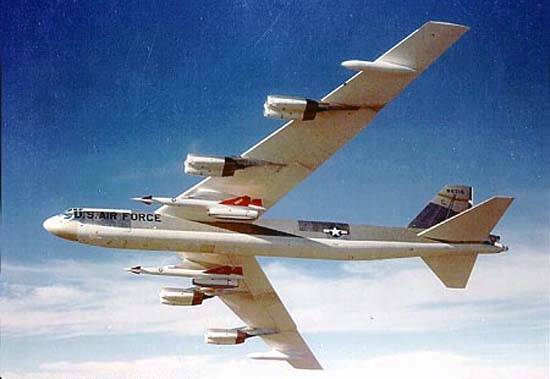
You can brush it off in the "hurray" style. Say, what is there, the Americans use the ancient artifact from hopelessness. Ancient does not mean "incapable". Do you know the ancient Su-24? Very ancient? And we no longer have a cruiser on the Black Sea. Roughly the same and B-52. Yes, it is old, but if necessary, this aircraft will definitely qualify for combat missions.
I will also say a very sacramental phrase: there was such a time. There were many very smart, talented and ideologically oriented people on both sides of the ocean. Who firmly believed that some were defending a democratic, while others were defending a communist future. And these people created simply masterpiece planes and ships, rockets and Tanks. It was not a business, it was a real struggle for your "tomorrow".
That is why such aircraft as the B-52 and Tu-95 were obtained. Therefore, now neither the United States nor Russia can even come close to creating something further. The people were different.
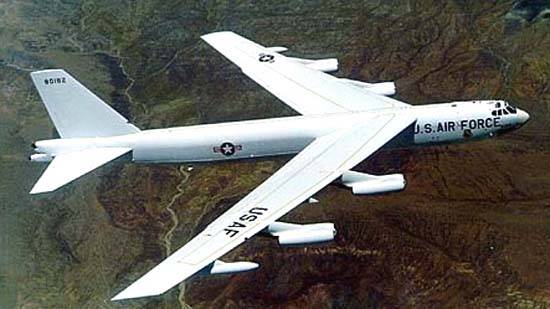
LTH B-52G
Wingspan, m: 56,39
Aircraft Length, m: 48,03
The height of the aircraft, m: 12,40
Wing area, м2: 371,60
Weight, kg
- empty aircraft: 76 405
- normal takeoff: 137 272
- maximum take-off: 221 352
Engines: 8 x Pratt & Whitney J57-P-43WW turbojet engines with a thrust of 5 kgf each (080 kgf with afterburner)
Maximum speed, km/h: 1
Cruising speed, km / h: 842
Ferry range, km: 12
Combat radius of action, km: 6 600
Max. rate of climb, m/min: 1 661
Practical ceiling, m: 14 326
Crew, prs: 6
Armament:
- four 12,7 mm M3 machine guns
Bomb load up to 22 680 kg
A total of 744 B-52 aircraft of various modifications were built, of which 71 aircraft were lost as a result of flight accidents. The last B-52H, serial number 61-0040, left the factory on October 26, 1962.
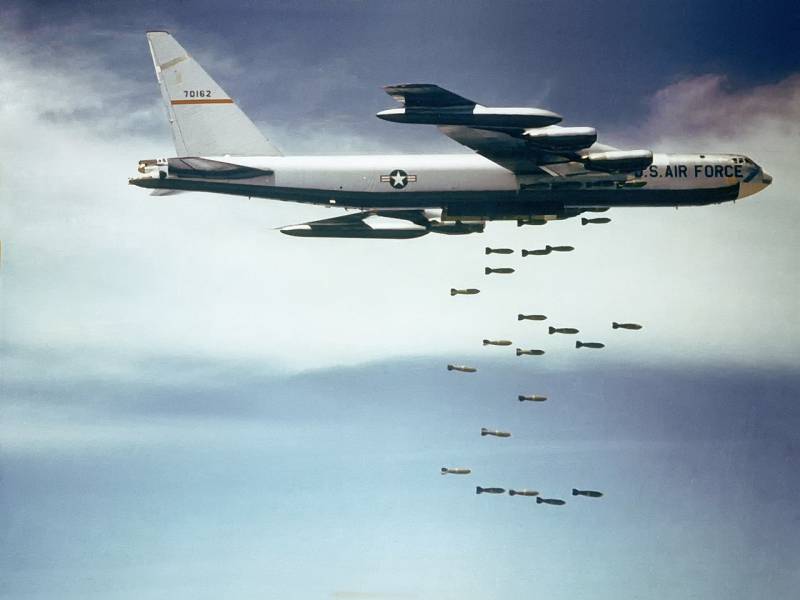





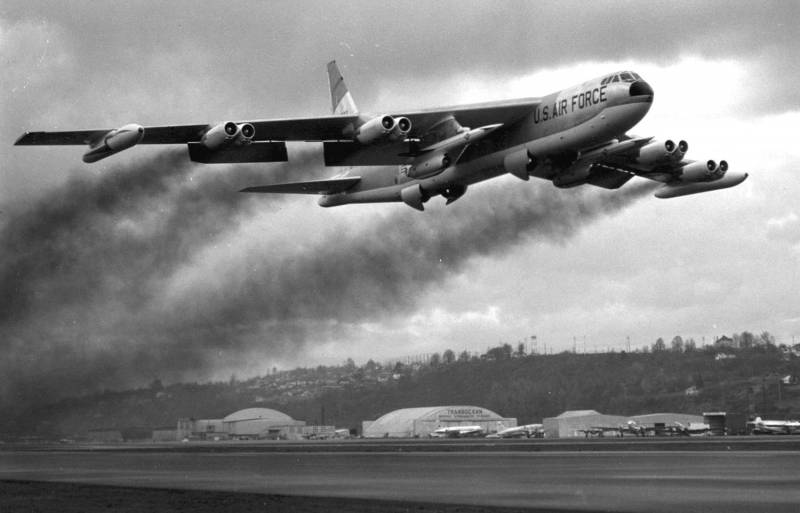

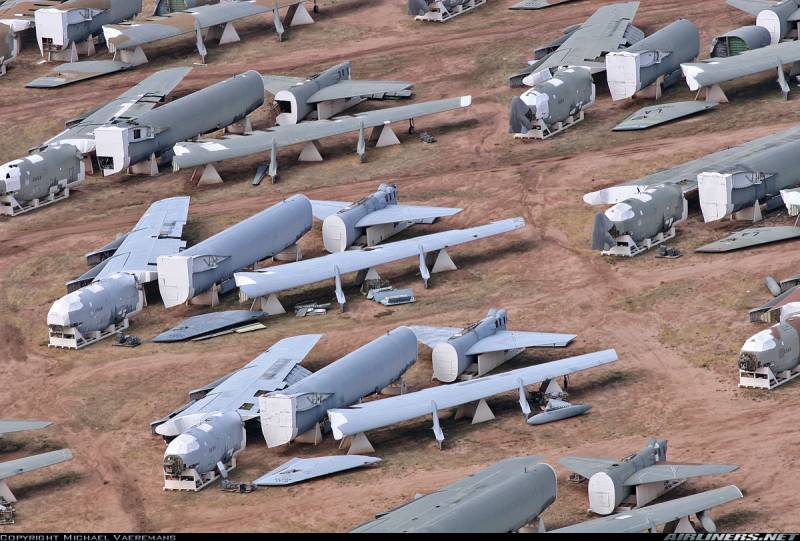
Information